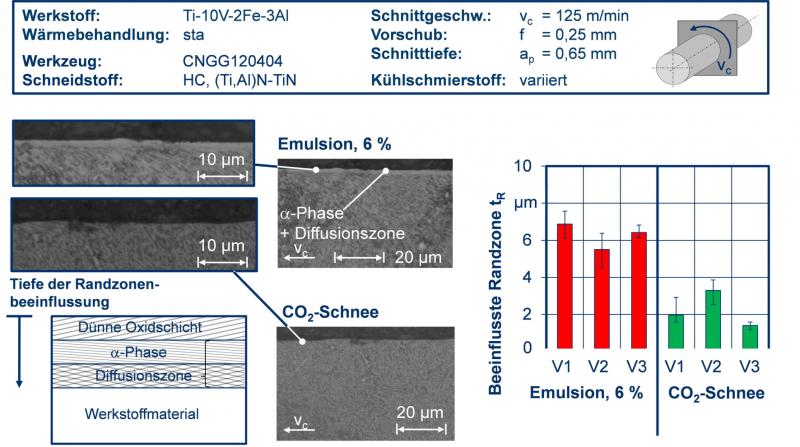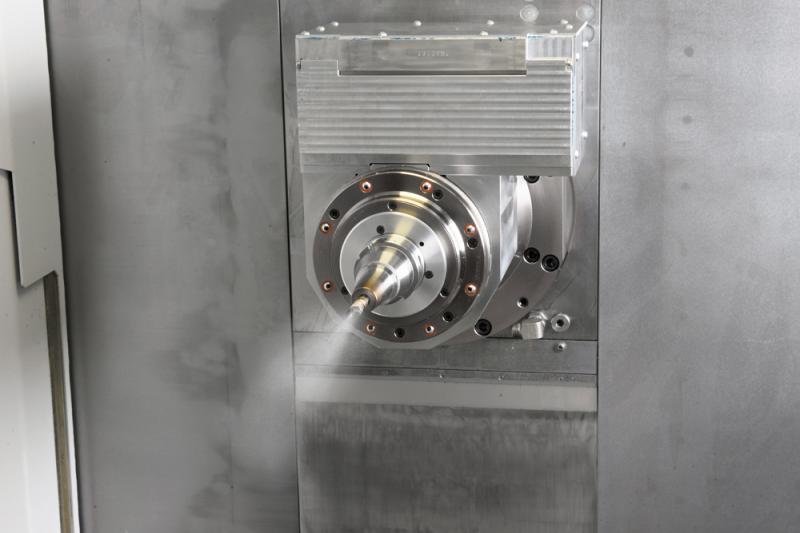Cryogenic cooling reduces wear and tear
METAV 2014 will showcase prospects for new cooling strategies
The boom in giant aircraft, particularly, is driving a radical transformation in the materials of choice: suddenly, titanium, nickel-based alloys, ultra-high-strength steels and carbon-fibre composites have to be machined on a large scale and at high levels of productivity. Conventional cooling lubricant concepts often come up against their physical limits here. The potential of cryogenic cooling compared to conventional processes has been rigorously examined by Hendrik Abrahams, a scientist on the staff of the Institute of Machining Technology (ISF) at Dortmund Technical University.
Hendrik Abrahams, a multitude of new materials are currently emerging. When and how did cryogenic technology, i.e. cooling with technical gases, come into play?
Abrahams: Cryogenic cooling is in itself nothing really new, since back in the 1950s, in the USA, there were some initial cooling trials with CO2. In the late 1990s, there was a major research project conducted by Columbia University with twelve industrial companies on nitrogen-based cooling. The ISF started off in 2003 with high-alloyed steels, and in the past few years has been doing intensive work on cryogenic cooling when machining special materials like titanium-based and nickel-based alloys. Cryogenic cooling is a wise choice for titanium-based alloys, particularly, because in terms of the blade material our choices are very restricted. Only hard metals can be used for the tools here, since blades made of ceramics and CBN already wear out after a short cutting time . In order to increase productivity levels when machining titanium with hard-metal tools, a responsively matched cooling concept is essential. Here, for example, high-pressure cooling lubrication has proved efficacious.
What other reasons are there for adopting new cooling concepts?
Abrahams: They enable the useful lifetime of the tools or the cutting speed to be increased, thus upping the productivity of the process involved. This is certainly a highly motivating factor, in the fast-growing aircraft industry, for instance, which because of the rising proportion of carbon-fibre is having to make increasing use of titanium as well.
What cooling concepts have you examined, and with what results?
Abrahams: ISF has conducted trials with flood, high-pressure, CO2 snow-jet cooling, plus combinations of cryogenic technology and minimal-quantity lubrication. In the case of Inconel 718, a nickel-based alloy for the high-temperature range, it emerged that with CO2 cooling pure and simple the lack of lubrication leads to severe wear and tear. A combination with minimal-quantity lubrication (quasi-dry machining) reduced the wear and tear on open areas, and notch-wear. The success stands and falls, however, with the type of feed involved, the pressure of minimal-quantity feeding and the right choice of cold-resistant minimal-quantity-lubrication oil. Action is still needed here on the design front.
With cryogenic cooling, you’re concentrating solely on CO2; what about nitrogen?
Abrahams: It depends on the type of tool cooling system involved. Internal tool cooling, which requires some quite elaborate engineering because coolant boreholes have to be provided, can be implemented only with nitrogen, since nitrogen remains at a temperature of almost –200°C during the entire feed process. For external feed of the coolant through nozzles, both nitrogen and CO2 are suitable. When it exits, the CO2 is at a temperature of minus 82°C, not as low as nitrogen, but the specific thermal capacity is higher, since the CO2 is kept in liquid form until it exits from the nozzle.
What makes you think that cryogenic cooling is a genuine trend and not just a hype, like other, earlier technical developments?
Abrahams: Firstly, the aircraft industry has a significant demand for more efficient processes, and secondly, from a researcher’s viewpoint, we’ve identified the salient advantages of cryogenic technology as an option for upgrading productivity levels. The interest is there: as evidenced by Premium Aerotec GmbH, one of the sector’s leading component suppliers, which has already purchased machines featuring cryogenic cooling and is trialling the technology concerned.
What about the costs involved?
Abrahams: The cost-efficiency of cryogenic cooling depends on the CO2 consumption. To reduce the costs for carbon dioxide consumption, we’ve already conducted studies on how to downsize consumption, where we’ve proved that with a significantly reduced CO2 mass flow – to be precise from 2.7 to 0.6 kilograms per minute – machining can be performed with equally good results. When the CO2 consumption is optimised and reduced still further, together with significant gains in productivity, it can be assumed that cryogenic cooling will pay off.
Will we be needing new tools for cryogenic snow-jet cooling?
Abrahams: New tools no, but modified ones yes. You can take the tools designed for high-pressure cooling, and adapt their nozzles to the CO2 snow-jet in terms of clearance, shape, diameter and where appropriate the position as well.
In other words, what’s taking shape here is something that the tool producers have long been urging: intensive cooperation between tool and machine-tool manufacturers?
Abrahams: Now, in the initial phase, the optimum scenario would be a major collaborative project with the machinery manufacturers, several tool producers, a manufacturer of nozzles, and a research institution like the ISF. There’s an option here, too, for participating in government-sponsored projects.
Then you, too, are doubtless expecting new approaches from the METAV 2014 as an inspiration for yourself as a scientist?
Abrahams: I shall be spending the entire week there to track down the latest developments in terms of machines and tools. It’s a good opportunity to give yourself a broad overview of all the innovations on offer.
The ISF has evidenced the fundamental suitability of CO2 snow-jet cooling; are you now focusing on the design details of the important process parameters?
Abrahams: We’ve already determined some important key statistics, such as possible increases in useful lifetime: the task now is to design-enhance the concept for series production. Here, all the disciplines involved have to work closely together.
Will the machine tools have to be modified?
Abrahams: You need a gas-tight, pressure-proof feed of the CO2 snow-jet through the revolver, and in the case of milling through the spindle. The design engineer, however, in contrast to nitrogen-based cooling, with its extremely low temperatures of around minus 200 degrees Celsius, doesn’t have to worry about thermo-compensation when designing the machinery. With CO2 cooling, it’s all pretty simple really: you need a tank in the machine and pressure-proof piping. This kind of cryogenic cooling, then, can be retrofitted with relative ease. So it’s also an obvious option for machinery manufacturers who want to gain some initial experience with it. In the case of nitrogen, the entire execution is more complicated.
What do you see as the highlight of your work?
Abrahams: We have proved experimentally that in the case of the titanium-based alloys the wear and tear can also be substantially reduced in comparison to high-pressure cooling. Moreover, effective cooling of the action point and the displacement of oxygen result in reduced influence on the peripheral zones.
CV
Hendrik Abrahams (born in 1984) studied mechanical engineering at Dortmund Technical University, majoring in production technology. Since 2011, the engineering graduate has been on the scientific staff at the Institute of Machining Technology (ISF).
Background
METAV 2014 in Düsseldorf
The next METAV will be held in Düsseldorf from 11 to 15 March 2014. In the even-numbered years, it is now firmly established as an important technology window showcasing the entire spectrum of production technology for manufacturers and customers from all over Europe. The METAV showcases the entire spectrum of production technology, focusing primarily on machine tools, manufacturing systems, high-precision tools, automated materials flows, computer technology, industrial electronics, and accessories. The target group for the METAV’s visitors includes all branches of industry that machine metal, particularly machinery and plant manufacturers, the automotive industry and its component suppliers, the aerospace sector, the electrical engineering industry, energy and medical technology, plus metalworking and the craft sector. At the last METAV in 2012, around 700 exhibitors from 26 different countries showcased their products, their manufacturing solutions and their service capabilities.






 Germany
Germany 